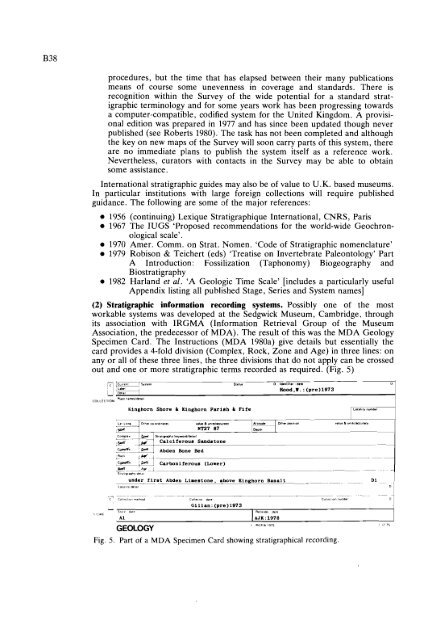GUIDELINES FOR THE CURATION OF GEOLOGICAL MATERIALS
GUIDELINES FOR THE CURATION OF GEOLOGICAL MATERIALS
GUIDELINES FOR THE CURATION OF GEOLOGICAL MATERIALS
Create successful ePaper yourself
Turn your PDF publications into a flip-book with our unique Google optimized e-Paper software.
p --<br />
~ ----<br />
~-~<br />
procedures, but the time that has elapsed between their many publications<br />
means of course some unevenness in coverage and standards. There is<br />
recognition within the Survey of the wide potential for a standard stratigraphic<br />
terminology and for some years work has been progressing towards<br />
a computer-compatible, codified system for the United Kingdom. A provisional<br />
edition was prepared in 1977 and has since been updated though never<br />
published (see Roberts 1980). The task has not been completed and although<br />
the key on new maps of the Survey will soon carry parts of this system, there<br />
are no immediate plans to publish the system itself as a reference work.<br />
Nevertheless, curators with contacts in the Survey may be able to obtain<br />
some assistance.<br />
International stratigraphic guides may also be of value to U.K. based museums.<br />
In particular institutions with large foreign collections will require published<br />
guidance. The following are some of the major references:<br />
1956 (continuing) Lexique Stratigraphique International, CNRS, Paris<br />
1967 The IUGS 'Proposed recommendations for the world-wide Geochronological<br />
scale'.<br />
1970 Amer. Comm. on Strat. Nomen. 'Code of Stratigraphic nomenclature'<br />
1979 Robison & Teichert (eds) 'Treatise on Invertebrate Paleontology' Part<br />
A Introduction: Fossilization (Taphonomy) Biogeography and<br />
Biostratigraphy<br />
1982 Harland et al. 'A Geologic Time Scale' [includes a particularly useful<br />
Appendix listing all published Stage, Series and System names]<br />
(2) Stratigraphic information recording systems. Possibly one of the most<br />
workable systems was developed at the Sedgwick Museum, Cambridge, through<br />
its association with IRGMA (Information Retrieval Group of the Museum<br />
Association, the predecessor of MDA). The result of this was the MDA Geology<br />
Specimen Card. The Instructions (MDA 1980a) give details but essentially the<br />
card provides a 4-fold division (Complex, Rock, Zone and Age) in three lines: on<br />
any or all of these three lines, the three divisions that do not apply can be crossed<br />
out and one or more stratigraphic terms recorded as required. (Fig. 5)<br />
3[FS"'te' Statm D 16.ntlll.r dam D<br />
CDLLICT,ON PIX~namti*t~l<br />
l<br />
Einghorn Shore I Kinghorn Parish I Fife<br />
I&od,W.:(pre)1973<br />
L., Long I Orher CD 0rdln.l.l ..,m b "nlsicrur.c, Al,.,.<br />
W<br />
C0mpi.x<br />
-. 2pl<br />
+ 9(<br />
C+"<br />
--<br />
Rori<br />
'-<br />
Slr.llrllhy k.yroldl~fli<br />
WT27 87<br />
Calciferous Sandstone<br />
Abden Bone Bed<br />
D.P,~<br />
Olh., p011110n ".,"l & unlt,irru.r"<br />
:PI( -<br />
--<br />
Carboniferous (~ower)<br />
I\?I~ pp.p.--- ~<br />
s!,a,#9raph" d?!~,,<br />
under first Abden Limestone, e v e Kinghorn Basalt ~<br />
.-P<br />
Lvr.11" *,all<br />
D1-j<br />
-<br />
,,.r<br />
~<br />
p ~ --pp.p.-p--.p--- -- -<br />
C Cullril,un method Collrrlor dale Colrrllon "urner D<br />
Gillan: (pre)l973<br />
S,O,P *I.F<br />
GEOLOGY<br />
r RGWI 19?5 1 0 1 5<br />
Fig. 5. Part of a MDA Specimen Card showing stratigraphical recording.

















